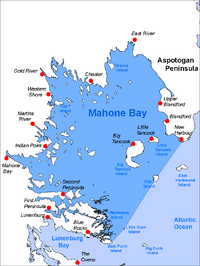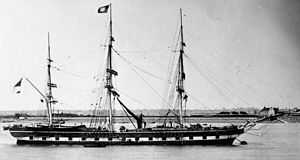Mahone Bay

- This article is about the water body. See Mahone Bay (town) for the article about the town.
Mahone Bay is a bay located on the Atlantic coast of Nova Scotia, Canada along the eastern end of Lunenburg County. Mahone Bay was named after the French mahonne (English: Barge), which referred to a type of boat used by local privateers.[1]
Geography
Opening south directly onto the Atlantic, its eastern shore is formed by the Aspotogan Peninsula and its western shore is formed by the First Peninsula (of Lunenburg). The Chester Peninsula juts several kilometres into Mahone Bay at roughly its midpoint.
The bay's geological history differs from its eastern neighbour, St. Margarets Bay, in that Mahone Bay shows a greater variety of soils and bedrock. Numerous glacial drumlins on the western shore near the towns of Mahone Bay and Lunenburg have resulted in small-scale farming operations.
Mahone Bay also differs from St. Margarets Bay in that it is dotted with innumerable small and medium-sized islands throughout its waters. The shelter provided by these islands, along with the summer southwesterly flow, led to the scenery around Mahone Bay becoming a tourist attraction in itself. Today the towns of Chester and Mahone Bay have become a destination for cruising in pleasure yachts. A scenic provincial park at Graves Island just east of Chester is a popular camping destination.
Mahone Bay is home to numerous picturesque working fishing communities, one of the most famous being the communities of Big Tancook and Little Tancook, located on Big Tancook Island and Little Tancook Island respectively. Other important fishing ports include Blandford.
History
Mahone Bay was first settled during Father Le Loutre's War. The first to arrive were those who lived in Lunenburg, Nova Scotia and had farm lots throughout the peninsula, including Mahone Bay. The people who settled this area include the present-day village of Mahone Bay, were foreign protestants who were German, Swiss, and Montbéliardais settlers.[2]
During the French and Indian War (which included the Expulsion of the Acadians), there were nine Native and Acadian (Catholic) raids against the protestant settlers on the Lunenburg Peninsula. The French, Acadians and natives were resisting the British control over Nova Scotia and Acadia. One such raid – the Raid on Lunenburg (1756) – happened just off the shores of Mahone Bay on present-day Covey Island and [John] Rous Island.

Another raid happened on 24 August 1758 in the village of Mahone Bay, when eight Mi'kmaq attacked the family homes of Lay and Brant. While they killed three people in the raid, the Mi'kmaq were unsuccessful in taking their scalps, which was the common practice for payment from the French.[3]
During the War of 1812, the American privateer schooner Young Teazer was trapped off the shores of Mahone Bay by the HMS Hogue (1811). To avoid capture, a crew member of the Young Teazer destroyed his own ship, killing most of the crew.[4]
In popular culture
Frank Parker Day's novel Rockbound takes place on the fictional island of the same name, which was based on the nearby island of East Ironbound and includes references to many other Mahone Bay islands and towns. Day visited the area and created Rockbound as a fictionalized, exaggerated account of life on the islands.
Mahone Bay contains Oak Island, well known in connection with tales of buried treasure.
The 2006 independent movie 'A Stone's Throw' was filmed primarily at locations in and around Mahone Bay.[5]
References
- ↑ The Canadian Encyclopedia
- ↑ Among the settlers were the Hyson, Zwicker, Keddy, Eisenhauer/Eisner, Weinacht/Whynot, Ernst, and Veinot families. All these names can be found in the area today. The old cemetery, known as Bayview Cemetery, has some 18th-century slate gravestones engraved in German.
- ↑ Bell, Wintrop Packard (1961). The "Foreign Protestants" and the Settlement of Nova Scotia: The History of a Piece of Arrested British Colonial Policy in the Eighteenth Century. University of Toronto Press. p. 511.
- ↑ Archibald MecMechan. Sagas of the Sea.
- ↑ "Follow Me Home, from The Coast, Sept 14, 2006".